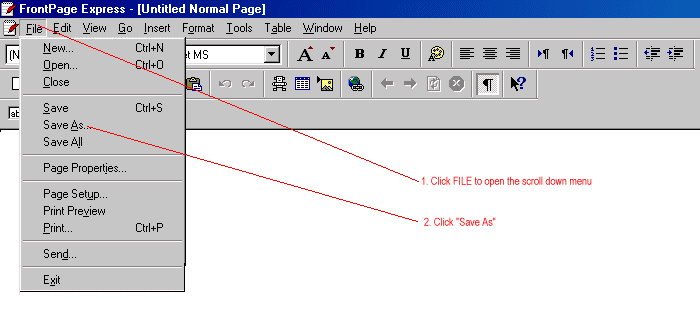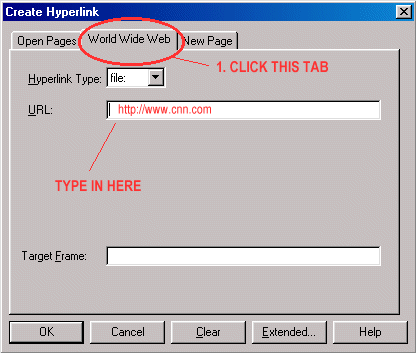PART 1
CREATE A WEBPAGE WITH FRONTPAGE
EXPRESS.
| "Webpages" in technical parlance are called "html files". Everytime you create a new page with Frontpage, you create a new html file. HTML means "hypertext mark-up language". | |
| 1. | Open FRONTPAGE EXPRESS. Here
is what the navigation bar looks like |
 |
|
| 2. | Click FILE. A scroll-down menu will open up. Click "Save As..." |
 |
| 3. | In the dialogue box that opens up, "Page Title" refers to the TITLE of your page, NOT THE FILE NAME. |
| In the text box Page Title you can type anything
you want (I would suggest a descriptive title of the page
content.) |
|
| 4. | Click the button "As File..." |
 |
| 5. | In the following dialogue box, you finally name your file. THE FIRST FILE OF A WEBSITE MUST BE CALLED <index> |
 |
| If you typed <index>, the FULL filename will be <index.htm> because FRONTPAGE EXPRESS automatically adds the .htm extension to any file created with it (the three or four letters after <filename.> are called EXTENSION) . | |
| If you typed <index.html> the filename will be <index.html>. Either one is OK. | |
| The important thing is that in your website you only have one index file, either with the extension .htm or .html but NEVER both. |
| 6. | Use FrontPage Express the way you would use Word or any other word processing program. Type in anything you want. |
Experiment with font color and size.  |
|
| After you finish, click FILE > SAVE (no need to do SAVE AS, since it already has a name). |
| a) | Start the browser (Internet Explorer), go to FILE > OPEN > BROWSE and OPEN the file you were working on. |
| b) | If you want to make changes,
work on the file in Frontpage Express. Click FILE > SAVE. |
| c) | Go back to the browser (Internet
Explorer) and click the "Refresh" button to
load the new version of your html file. |
| 13 | INSERTING AN ACTIVE LINK IN YOUR HOMEPAGE |
| Let's assume you
want to place a link to the Website of CNN in your
webpage If you go to the CNN site you will see that the full URL is <http://www.cnn.com>. Copy the entire URL from the "Address" linebox (highlight the URL, right click, click "Copy"). Paste it into the Frontpage document (place the cursor anywhere on the blank screen, right click, click "Paste"). Click "ENTER". It should activate itself automatically (it turns blue with an underline). If you can't copy and paste, type the entire string, <http://www.cnn.com>. Click "ENTER". It should activate automatically (it turns blue with an underline). THE LINK WILL LOOK LIKE THIS
|
| 13b | A different way of INSERTING AN ACTIVE LINK IN YOUR HOMEPAGE |
| In Frontpage Express, in the
navigation bar, click INSERT > HYPERLINK In the dialogue box, type the URL of the site you want to link to and click OK  THE LINK WILL STILL
LOOK LIKE THIS Click FILE > SAVE and test in your browser. |
| 14 | TURN ANY WORD INTO AN ACTIVE LINK |
| You can turn any word or string of
words into an active link (aka hyperlink) Type any word in Frontpage Express. Highlight it by double-clicking on it On the navigation bar click INSERT > HYPERLINK (see 13b) See the dialogue box above and repeat. THE LINK WILL LOOK
LIKE THIS Click FILE > SAVE and test in your browser |
| 15 | TURN ANY IMAGE INTO AN ACTIVE LINK |
| In Frontpage Express, insert an image
(see n. 9) Place the cursor on the image you just inserted and RIGHT CLICK. Click "Image Properties" |
|
| This dialogue box will open up
THE LINK WILL
LOOK LIKE THIS Click OK then FILE > SAVE |
| 16 | LINKING TWO OR MORE OF YOUR WEBPAGES THROUGH HYPERLINKS |
| Your first webpage MUST be called <index.htm>
or <index.html>. Let's assume you have created another page (see n. 7) and called it <pagetwo>. The full name of the file is <pagetwo.htm>. In Frontpage open the <index.> file. Anywhere in the page, type any word you want (Link, Page 2, Next, Forward etc.) Transform this WORD or string of words into an active link (see n. 14) In the dialogue box, for URL simply type <pagetwo.htm> (DO NOT TYPE THE BRACKETS < >) Click OK Test the link in your browser. Now, in
Frontpage Express open <pagetwo.htm>. |
| 16b | ONE LAST TRICK: HOW TO CREATE AN
ACTIVE LINK THAT OPENS INTO A NEW BROWSER WINDOW. Place the cursor on any active link. RIGHT CLICK. At the bottom of the dialogue box that opens up, for Target Frame, type in EXACTLY <_blank> (there must be an underscore before the word blank). CLICK OK, FILE > SAVE. Test in your browser. |
PART 2
UPLOAD YOUR FILES TO THE WEB WITH FTP.
| 17 | Start the FTP program
WS_FTP95.
|
| 18 | CLICK OK. Follow the directions below.
VERY
IMPORTANT |
| 19 | THIS OPERATION UPLOADS YOUR FILES FROM YOUR
COMPUTER TO THE WEBSITE .
Repeat the operation with every single file you want to upload. |
| 20 | VERY IMPORTANT: YOU
MUST UPLOAD ALL THE HTML FILES AND ALL THE IMAGES YOU MUST UPLOAD EVERY HTML FILE AND EVERY IMAGE YOU USE IN YOUR WEBPAGES. To do so, repeat the process in n.19 for each file. |